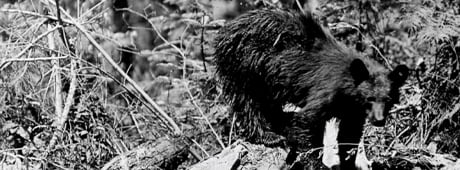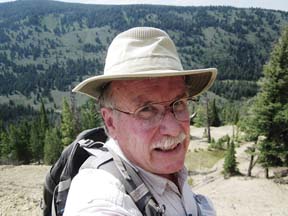No products in the cart.
Bear Faced

And a Lion, Too
By Ray Brooks
I saw my first Idaho black bear at about age ten, while driving up a narrow dirt road near Ketchum with my mother. The bear was turning over rocks and pieces of dead tree trunks, searching for ants and grubs in a meadow below the road, about a hundred yards away from us. My mom stopped our big pickup, jumped out with her trusty .30-30 open-sights rifle, and as the bear started loping away, dropped him with a heart shot. The fat yearling bear was a supplement to the winter wild meat supply for our family. Both my parents repeatedly insisted, “It tastes just like pork,” and I learned to somewhat enjoy the dark and fatty bear meat. A family friend who was a pastry chef in Sun Valley told us that bear lard helped make delicious pie crusts and cookies and begged my parents for some. My mother soon started making chocolate chip cookies with it, too. Best cookies I’ve ever eaten.
When I grew up in central Idaho in the 1950s and ‘60s, bears and mountain lions were a rare sight. Both had been nearly hunted to extinction, since stockmen hated them, for defensible reasons. Bears and mountain lions would attack sheep, cattle, and horses, and their scent or sight could also stampede livestock. From 1915 to 1958, Idaho mountain lions carried a bounty, and bears were hunted for their tasty meat and luxurious pelts. The few lions and bears that survived in Idaho became expert at avoiding humans.
I did not see another Idaho bear until I was twenty years old. While I was on horseback, doing Forest Service trail maintenance, a mom bear ran in front of my co-worker’s horse, which immediately started bucking. When her two cubs then ran across the trail in front of me, my horse also set to a buck-fest but I managed to stay in the saddle.
In those days, I was convinced that black bears were timid creatures and were scared to death of us evil humans. The next year I was on a late evening walk with a girlfriend near her northern Idaho home when a bear and her cubs appeared about a hundred yards away. I sternly yelled, “Hey, bear,” convinced this would spook them. Instead, the mom bear stood up and woofed at us. We backed away, loudly apologizing. I decided the bear had not recognized us as humans in the dim evening light and I continued to believe that Idaho bears were scared of humans. Even so, I was aware that the grizzly bears that resided in some remote parts of Idaho, neighboring Montana, and western Canada were not scared of humans.
This content is available for purchase. Please select from available options.
Purchase Only
Purchase Only

